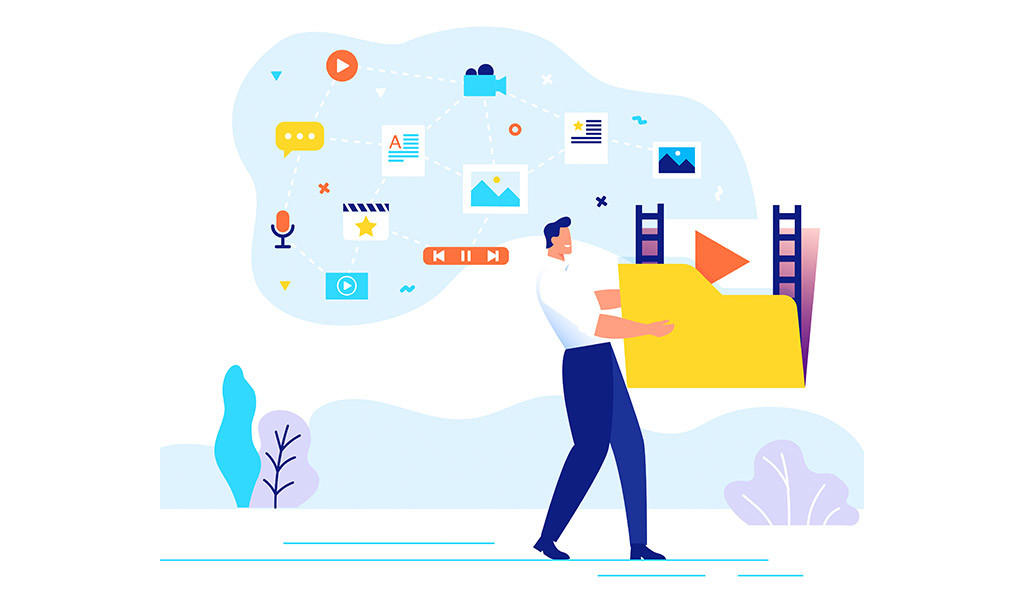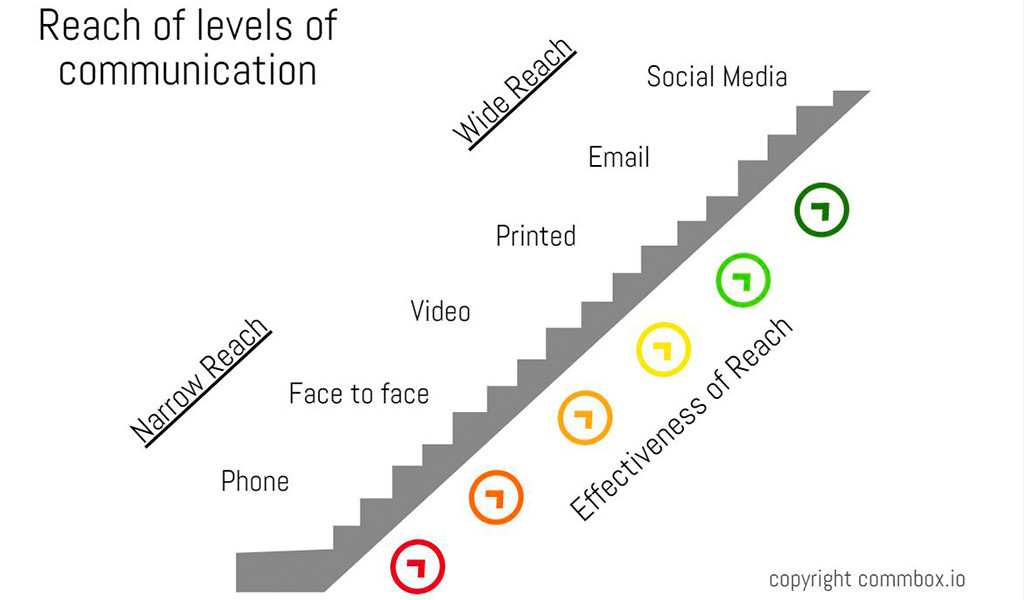
Depending on your business, there will be a number of communication channels that are the preferred methods of communicating with you by your customers.
In this article, we’re going to go over what those communication channels might be, which ones are the most preferred top channels, and some statistics around it that you might want to start gathering for your business.
But first, let’s dive into what we mean by communication channel with this quick round-up answer, then we’ll head into more details…
What is meant by a communication channel? When businesses communicate with their customers, the medium by which they communicate is referred to as a communication channel. Examples include email, phone, or social media channels such as Facebook, WhatsApp, or even chatbots. The trick is which ones to use and how to integrate them into what you do.
You might also want to know what is meant by “communication” or at least what we mean by “communication” in this article.
Communication formats
We can also largely define communication as being a medium, a means, of communication, which includes the manner, or method by which an intended message is sent – by a sender, to its intended recipient, or audience.
Most communication channels can be covered with using some basic formats, there’s written hard copy (written or printed), or digital formats. There’s oral or spoken, and then we move on to multimedia, social and the more electronic formats. Even the mores code used to be an effective communication channel!
Communication style
The manner in which we communicate can be among a variety of methods. In business, communications are often considered formal, informal, or even unofficial. Finally, there are different levels of richness, communications can be rich or minimal.
So which communications channels will work for your business? Before we dive into that, let’s take a look at how many you need and the effects each channel can have. Later we’ll offer an easy solution to cover all of them!
Which communication channel?
New businesses starting out will often fall into the trap of thinking they need to enter into all of the available channels possible in order to capture all of their customer’s communication options.
This can often work, for larger businesses, this is often what they do, and there are ways in which you can make the whole system run much more smoothly – more on how to do that later.
Too many communication channels
The problem with attempting to manage and remain active on all possible communication channels is more often than not down to costs – well isn’t everything? Some costs are associated with managing subscriptions to some channels for special features, but most of the costs will be due to simple labor hours required.
Managing a couple of communication channels such as a phone and email is what most staff are capable of doing. You can then add in a social media platform and that might be ok, but add in more and the whole process of managing workload then becomes trickier.
If we then see even a modicum of success then we double-down on our efforts and employ more staff, or pull them from other tasks in order to help manage the “Social Media” side. But are the returns worth this investment?…
Communication channels take time to grow
Many channels are not an instant hit. They take time and effort to build up a following, time and effort required to maintain a presence, with posts, product features, highlights, and customer stories. Then there are the responses that are required back and forth with customers – after all, that’s what the point of using communication channels is, right?
Some manage it, but many don’t. Channels get left or those deemed too slow to grow fall behind. Before you know it you find you will settle back into just a couple of channels. And then you’ll perhaps never know which ones were going to work best!
But one channel might have been the best medium for you, and it’s just too important to be left behind. But how important are business channels anyway?
How important are communication channels to business?
There’s less pressure on business communications that are internal, it’s the communications that are customer-facing that are the real pressure points for a business. They have to be right – every time. Good initial and ongoing contact with a customer can make a big difference to a company if that customer then becomes a life-long buyer.
Needless to say, without some form of communication channel you don’t really have a business. Whether it’s just a cell phone number of a door to door approach, there has to be interaction. The level of interaction, the breadth of interaction and the richness of that interaction all play a part in how important it is for your business.
Let’s explain this a little further, as we’re starting to head toward aspects like semantic levels and reach.
Different communication channels yield different results, let’s take a quick look at a comparison between face to face communication and other potential communication channels.
Personal rapport
Two people talking face to face can have an instant rapport and a deeper semantic business relationship than someone at the end of an email.
Faster communication
Talking face to face is also much faster, more can be communicated in a short space of time. Decisions can be made quicker and human interactions and friendliness are more obvious and natural. It ends in a handshake and a smile – perfect!
Personalized messaging
Face to face business meetings are most often centered around just the relationship between that customer and the business, it’s far more personal service than most other channels. This semantic level is deeper than an email response. This is what we mean by rich or minimal communication.
Limited audience
However, talking face to face, although one of the most valuable channels of communication, is also one of the most limited… in most business meetings, one person – or a few people, are talking to a few other people.
The message is more personalized, but the audience is smaller. Even a seminar or speech only reaches so many, and it’s only a one-way conversation. In this digital age, where meetings and information are instant, the face to face meeting – unless it’s face to face online – is becoming limited. A single tweet can reach an audience of thousands – almost instantly – and repeatedly.
Costly
With the exceptions of retail and perhaps high-ticket products or services, how many staff can a business reasonably afford to be having one-on-one conversations with its customers? This largely depends on your business setup. For many, it involves large additional travel costs and other expenses – even before the conversation happens.
Here’s a couple of charts we’ve designed which outline some of the pros and cons of each channel. In general terms, a small communication channel – or level can be more effective, but a social media channel can reach a wider audience.

It’s about balance, and for balance, you ideally need to utilize a number of different channels as you take customers through your customer service path, or your sales funnel. The omnichannel approach.
Omnichannel means you can cover all bases, from narrow customer focused and rich communication to a wider, broad messaging medium – more on that later…
The reach just about turns the list on its head. So we can, therefore, assume that all of them are important communication channels for a successful customer-centered business.
So it should be about balance then. As we move into 2020, taking a more omnichannel approach with the top communications channels will become increasingly important in providing a varied and appropriate mix of communication levels for your audience.
“Omnichannel means you can cover all bases, from narrow customer focussed and rich communication, to a wider, broad messaging medium”
Communication channels by demographics
Another factor to consider is your audience. Different generations prefer and lean toward different communication channels. Older generations often take to social media less than newer generations. If you’re in the business of aids for the elderly, consider what communication channels are potentially a more effective medium for your customer
Generation Z – the customers of the future
The latest generation to hit the scene is Generation Z, those born after around 1997 are now turning into one of the largest spending groups and are the customers of the future that we need to appeal to.
This group will represent around 46% of the entire consumer spending during 2020 and this is likely to increase beyond that. So, the methods they choose to communicate with their chosen brands matters to you.
Gen Z spends an average of 6 hours a day online, they are the most widely based users of the most recent social media channels like WhatsApp and Instagram.
So, for example, in case you’re selling the latest fashion for the younger generation, then for this generation at least, you need to have your full range of social media firepower to cope with the numerous communication channels. And it’s not just us saying this…
Forbes said…
42% percent of Gen Z respondents in a recent study said they would participate in an online game for a campaign and forty-three percent would write a product review.
Business Wire says…
60% of Gen Z folks are more likely than average consumers to hang up if their call isn’t answered in under 45 seconds. Showing they may value fast, responsive customer service more than other age groups
Retail Touchpoints say…
47% of U.S. Gen Z consumers research items on mobile devices while shopping at brick-and-mortar locations
What are these communication channels?
Many of us are aware of the main communication channels but take a look at this list, it’s extensive how many channels you could actually use reach your customer, in no particular order…
- Phone
- Chatbot
- YouTube
- Face to Face
- Foursquare
- Quora
- Other general or topic focused forums
And many more…
We’re not going to dive into each one today, perhaps another time. But each of these channels has its positives and negatives, each appeal to different audiences, each has a different semantic level of communication and each has value – to the right business.
Which Social Media channel should I use?
This is only really a question you can answer, but there’s also a simple answer – manage all of them.
One basic rule to follow is that the deeper emotional context required of the message, then the richer the medium you should use. An extreme example is that no one likes to be told really bad news by email – or text. Hopefully, that helps you understand the point.
But remember, it doesn’t just have to be one single channel, even a face-to-face business meeting can include others on a video call, or audience participation via a twitter feed. And/or meetings can be followed up with an email or even a written letter – yes, they still exist!
Let’s give you a quick rundown on what our statistics are for our main social media channels, then we’ll tell you how we manage so many, seamlessly – and all at once!
Our statistics for social media channels
We’ve found that according to our records these are the most in use customer favorite communication channels –
| Channel | Use Percentage |
| Chatbot | 44% |
| 42% | |
| 34% | |
| SMS | 32% |
| 28% | |
| 19% |
As you can see from the chart below, customers vary the use by which they contact us, many use multiple channels – because their preferences, demographics and other factors differ.
Our channels are spread evenly across multiple platforms. So, across all our customers and all their contact points, we can see a breakdown of the wider percentage of use.

How do we know this?
We know this detail not because we’ve trawled through thousands of conversations and tweets and other social media data. That would be a difficult task.
We know this because we use our own product to measure all- CommBox. CommBox platform features allows us to not only seamlessly integrate and manage all of our social media channels, but it also provides a wealth of analytical data we can use, and productivity saving features that make managing every communication channel easier.
Advantages of using CommBox
You’re able to manage customer communications across a variety of channels at the same time.
Seamlessly
You’re able to utilize the same staff who are all hooked into the system and can understand every customer’s communication and respond to any customer communication too.
Cost/Labor efficient
That can be achieved by using a smaller amount of staff, who can easily be aware of all a customer’s history and interactions at a glance. So, you’ll able to spread our labor costs across a number of various communication channels.
Minimal industry effects
The social media world is an ever-changing place, platforms change their T&Cs all the time and the way they operate. However, with CommBox, you’re not just relying on one medium to conduct your business, if something were to happen to Facebook for example, then it would only affect approximately 25% of your business.
Wider messaging
This also means you’re able to spread our message across a large number of different mediums, across a number of different demographics – and time zones, to an exponentially larger and more varied audience as you see a fit.
Flexible and modular
It’s totally flexible for to your business needs. For instance, if you decided that you wanted to add a YouTube Channel, then no problem, simply head over to your personal project manager and the channel will be added to your CommBox account.
Or in case you’ve decided Facebook wasn’t enough for you, then fine, you can for example add in the LinkedIn module – but you can still keep your Facebook module going in case it started to pick up. It’s totally flexible!
That’s the omnichannel approach
Combining every digital channel available to you, alongside staff who are able to interact with each channel seamlessly, that are also hooked directly into our CRM, provides a much easier and seamless experience for our customers – and for us! Providing an omnichannel approach is not only important …it’s becoming essential.
We offer our CommBox modules and omnichannel approach for a wealth of communication channels, does your business provide customer service through these channels? If so, then make it easy on yourself and your staff to manage these channels and put the emphasis back on providing great customer service.
Want to move to omnichannel? – Then choose just about any method to contact us, why not use THIS channel to get in touch, and we’ll be happy to help